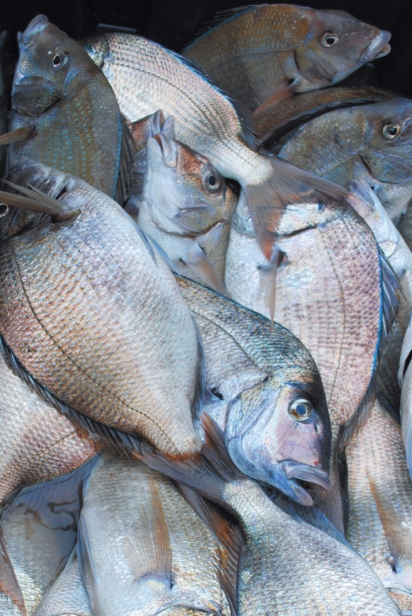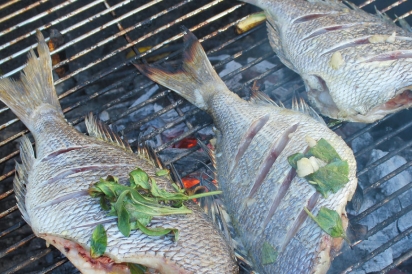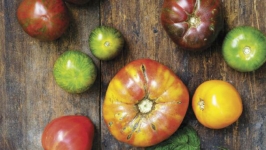The Tale of Scup and Butterfish: Please Don't Call Them Trash
Few Rhode Islanders know that Point Judith, or Galilee, carved its way into the seafood trade by catching and selling fish no one else really wanted. Sure, boats still landed trips of codfish and yellowtail flounder, but the port—all the infrastructure, from the fish plants to the ice houses; all the hustle and bustle that one sees on the waterfront—came from the sales of fish that few Americans ever thought about: scup and butterfish, whiting or squid.
For many years, all through the ‘60s and well into the ‘70s, even Rhode Island fishermen called them trash fish—or swill. These fish were worth pennies a pound. When the boats landed them, the fish were ground up for meal, en masse. Most Point Judith fishermen who were there in the early years would agree that people in other more traditional cod and flounder ports—New Bedford, Boston, Portland and Gloucester—looked down at Point Judith as a swill port, a port trying to figure out how to make a dollar selling so-called underutilized species, until money was made.
Yet even today, decades after Point Judith fully entered the fish trade, you need to have a real desire (or local knowhow) in order to purchase butterfish, scup or whiting in this state, despite the fact that hundreds of thousands of pounds of each are landed here every year.
Why are these fish hard to find locally? It has nothing to do with abundance—the stocks are healthy and the quotas often allow for nearly year-round harvest.
Squid is really the only one that can be readily found in the local marketplace. Interestingly, after only 25 years, Rhode Island squid has gone from dumpster product to a domestic and international player in seafood sales. It has, in a very short time, made Point Judith the largest squid port on the eastern seaboard. But that’s another story, worthy of more ink than can be given here. Same goes for whiting—that sleek silver fish that’s in the codfish family—delicious if bought fresh off the boat but often soft and listless when not.
Butterfish
Butterfish almost by itself built the port of Galilee. This very simple fish, going about its ways in the deeper waters south of Block Island and Martha’s Vineyard, small, flat in shape, like a minnow pressed into a pancake. With skin brighter than a polished quarter, a fish worth close to nothing per pound, it seemingly overnight became a sensation in Japan—a near-delicacy that was craved by enough people to drive the market.
Butterfish took off like a garage band with no gigs one day that finds itself headlining Gillette Stadium the next. For a solid decade, Rhode Island sellers were the link with butterfish buyers in the two key Japanese cities of Numazu and Oarai. The buyers wanted not just any butterfish. They wanted a specific butterfish, one that was full of fat but with an empty stomach. They wanted the fish to be soft, like butter. The fish were put on auction in Japan where they were graded for quality. The best fish fetched the highest prices.
Once purchased, the Japanese would take the fish and butterfly cut them. Salt was added and the fish were dried on wooden racks—millions of pounds of them. After this process, the fish were grilled and served, often for breakfast.
“We’d eat them like Americans eat eggs,” said Hitoshi Toyama, a Rhode Island fish buyer who moved to Rhode Island from Japan in the 1980s to be a link from here to there. “They are a very good fish.”
Then, as quickly as it had started, the boom was over. The heavy fishing pressure drove the size of the butterfish down. That, along with a Japanese recession, plus buyers unwilling to pay the higher prices. Buyers began looking elsewhere for a new fish that could fill the butterfish niche. They found one with a horse mackerel from northern Europe, which the Japanese called saba.
“That was it,” said Glenn Goodwin, co-owner of Seafreeze, a North Kingstown seafood processor. “The bulk of the Japanese population that grew up with butterfish on their plates now had horse mackerel. Their taste buds began to change. They started to forget about the flavor of butterfish. Now we’re trying to get that market back. It isn’t easy. It takes time.”
The export market for butterfish still exists but at a much smaller scale. Much of the butterfish that remain in the domestic market are sold in Asian markets and restaurants, often in the big cities.
Can more New Englanders eat them locally—where they are caught? It’s hard to say. Right now, butterfish remain an unfamiliar fish to most home cooks—but if tilapia rose to fame in a mere decade, going from unheard of to the fourth most consumed fish product in this country, then why not butterfish? Plus it’s completely pure, nothing added, no genetic modification like many farmed fish.
Scup
The scup, another silver fish which looks like a freshwater sunfish in shape with big scales and a sharp dorsal spine, is also plentiful off our coast. In 2013, according to the Atlantic States Marine Fisheries Commission, 12 million pounds were landed between Maine and the Carolinas, with the most weight being harvested from New Jersey and Rhode Island. When caught, most of the scup remains in the domestic market, often ending up in Baltimore, Atlanta, Philadelphia and New York.
“It goes into the ethnic markets,” Goodwin said. “We land the fish up here and truck them southward.”
Why is it that scup are often hovering around the status of trash fish within the food media? A few in the industry think the name is responsible for its weaker sales. A lot of people from the Mid-Atlantic states call them porgies. Up here we don’t call them that because it’d be too easy to confuse porgies for another fish, common in Narragansett Bay, called the pogy. On some Rhode Island menus scup is being sold as silver snapper.
“I hate the term ‘trash fish,’” said Benjamin Sukle, chef and part owner of restaurant birch in Providence. “What does ‘trash fish’ even mean? I call the fish by the fish’s name—scup, fluke, whatever. We sell a lot of scup here. People really like it.”
Why are scup and butterfish always lagging way behind? The answer possibly lies in what seafood writer Paul Greenberg discussed on NPR’s “Fresh Air,” talking about why Americans aren’t bigger fish fans. He brought up the three big reasons: Don’t know what to do with it; Don’t want to touch it; Don’t want it stinking up the kitchen.
This keeps the fish, especially fish like scup and whiting, herring and mackerel, from being bought by a huge percentage of the American population, a population very happy eating imported shrimp, tilapia, tuna and farmed salmon.
Most Americans don’t know what to do with fish—they want their squid to look like onion rings and their fish to look like chicken fingers. Thankfully there are many, especially smaller restaurants like birch and others, serving a wide range of fish that are not commonly found on menus.
“We serve the fish brought to us by a few Point Judith fishermen,” said Sukle. “[Directly] from them to us. It’s a remarkable relationship that we’re proud of. If they catch scup we serve scup. We have butterfish on the menu but mostly as a broth. I’d love to try the Japanese way of doing it, and would love to see a Rhode Island smoke and drying house open up.”
They’re What’s for Dinner
I recently got a text message from Rhode Island resident Chris Chivers. He was back from assignment in Iraq and wanted to let me know he had just caught some scup. (When Chivers isn’t fishing he is a Pulitzer Prize—winning reporter for The New York Times covering conflict and war.)
I walked over to his place and found Chivers with one of his five kids in the back yard cleaning fish.
“I love scup,” Chivers said as he handed me one. His second-oldest son, 12-year-old Mick, was hunched over, busy scaling the small fish. Scales flew like confetti at a wedding. Both he and his dad were covered in them. “I either fillet and skin them or I keep them whole. I roll the fillets in breadcrumbs and sauté them. My kids eat them like they would chicken.”
He’ll also grill the scup. He takes a whole fish and scales it with the head on. Then he cuts the head off and removes the guts. He’ll marinate the fish for hours in garlic, sage, salt and oil before putting it on the grill.
Chivers’ kids are the future scup eaters, their taste buds molding around the flavor and texture, around the sight of a whole fish in the kitchen. They eat striper and sea bass and eel, as well. Whatever Chris catches.
I asked him about butterfish.
“Never had them,” he said. “But I’d eat them if I could catch them.”
One things is for sure: Chivers doesn’t call any fish he catches trash fish. He calls it dinner.
RETAILERS WHO OFTEN CARRY WHOLE SCUP AND BUTTERFISH
Champlin’s Seafood
256 Great Island Rd., Narragansett, RI
401.783.3152
Aquidneck Lobster Co.
31 Bowens Wharf, Newport, RI
401.846.0106
(Call ahead of time to be sure they are available. You might ask them to scale the scup. Not everyone wants to be covered in confetti.)








